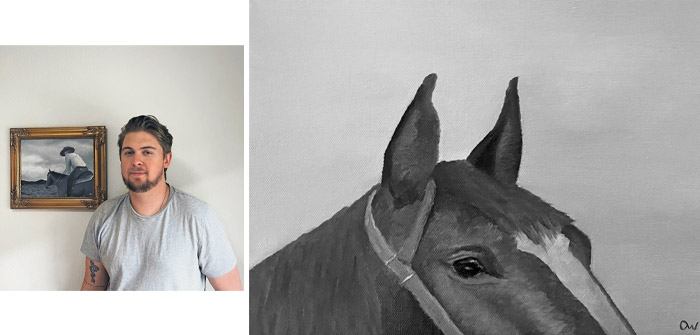(Peripheral by Oscar White)
Oscar White, an oil painter fresh on the local scene who focuses on wild and rugged Western iconography, began his journey as a creative of a different medium. Instead of pursuing painting and drawing like many young artists, Oscar began as a creative writer who discovered what artistic expression could mean when he got his MFA in creative writing.
Born in Seattle and raised in Bellingham, Washington, Oscar was a sports-kid growing up, with a family that encouraged him to pursue baseball and football. “When I was growing up, I really just took art classes because I had to,” Oscar said. “My only real exposure to art was through my grandmother, who was an oil painter who also taught art on-and-off for most of her career. I feel like I always had it in me, but no one other than my grandmother gave me a window into that world.”
While pursuing a creative writing degree, Oscar was exposed to creative ways of thinking that transcend any given medium. “The later years of my education taught me what art could be, and I saw the significance of that artistic expression, especially in the visual arts,” he said.
Although the appreciation was there, Oscar wouldn’t explore the visual arts until he had to complete a writing residency for his MFA. “I had this experience where I had to complete between 100 and 150 hours of an activity that could be classified as writing research,” Oscar said. “This was during the pandemic shutdowns, and because I couldn’t really find many other opportunities at the time, I decided to fulfill my hours by painting the characters of the book I was writing that took place in the Wild West.”
In this way, Oscar’s love of reading and writing historical fiction led him to discover a new love: oil painting, specifically Western themes. “Most of what I paint is influenced by the kind of works I love to read and write,” he said. “When I’m writing, I’m visualizing everything in my mind, already. Painting allows me to give my characters a face and bring them to life.”
One of the reason’s Oscar is so interested in the West is due to how the Wild West has been portrayed in American media, “I was always fascinated by this bubble of romanticism that we have for the American West,” he said. “The Wild West was somewhat modern, in terms of world history. What I find interesting is that it really wasn’t as glamorous as many modern and classic portrayals would make it seem.”
When the Wild West is brought up, many people think about popular Hollywood renditions; dramatic saloon entrances, shootouts at sundown, tons of fully black and white outfits that look great on camera, but would fall apart after a week working on the ranch. “The reality of the West is a far more gritty one,” Oscar said. “When I started getting into literature, I became fascinated by the books and works of writing that showcased the shocking reality of the Wild West. It was a dark part of our history, politically and socioeconomically. It was a tough time for so many people that is often overshadowed by this idea of the West being a mythical bounty full of freedom and wide open plains.”
Tons of Oscar’s passion for painting the West came from researching his novel, which is still in the works. He discovered that the more you dive into an individual state’s, town’s or person’s history, the more you will find gritty stories. “Hollywood loves to put someone like Clint Eastwood in Arizona and make that lifestyle feel manly and admirable,” he said. “The reality is just so far from that.”
When it comes to his paintings, Oscar strives to show the reality of the West. As an artist, he holds realism and accuracy in high regards and he hopes that his work provides people a more realistic and modern view of the West. “I describe my work as neo-Western, because while I use plenty of classic Western iconography, I also do it in a non-traditional way that avoids an overly romanticized portrayal.”
Oscar enjoys using minimalist design and often paints on a monochromatic, black and white style. His work often portrays a single figure and nothing else; even his landscape work is free from animals and other things that would take up space in the peripheral. From the outside, these choices might appear random, but there is a deeper thought process behind these style choices.
The darker themes in the paintings, that somewhat gothic aspect that comes through in Oscar’s use of black and white reflects the dark and gritty history of the West. The minimalist, no fluff style he has in his paintings directly reflect the very lifestyle that many people living in the real Wild West practiced; minimalistic and utilitarian practices. “In reality, the West was full of working people who owned one pair of jeans, one pair of boots, and one hat,” Oscar said. “There was no room for fluff or to be flashy, and every item owned served some sort or utility purpose.”
In the same way that these people had no time nor the resources to be flashy, Oscar wastes no time being flashy with his art. Each piece focuses on the subject at hand and is mostly free from any other distractions, “People came out there looking for opportunity and oftentimes had nothing to carry with them,” he said. “That minimalism comes through in my work. It’s not trying to be flashy and romanticized. These were hard times that people struggled through. My aim isn’t to specifically show the struggle, but to show the West in an honest light.”
Get a glimpse at Oscar’s work at The Grove’s art show from December 3 to January 6.

